Susan Cummins, Damian Skinner, and Cindi Strauss, In Flux: American Jewelry and the Counterculture. Stuttgart: Arnoldsche Art Publishers, 2020
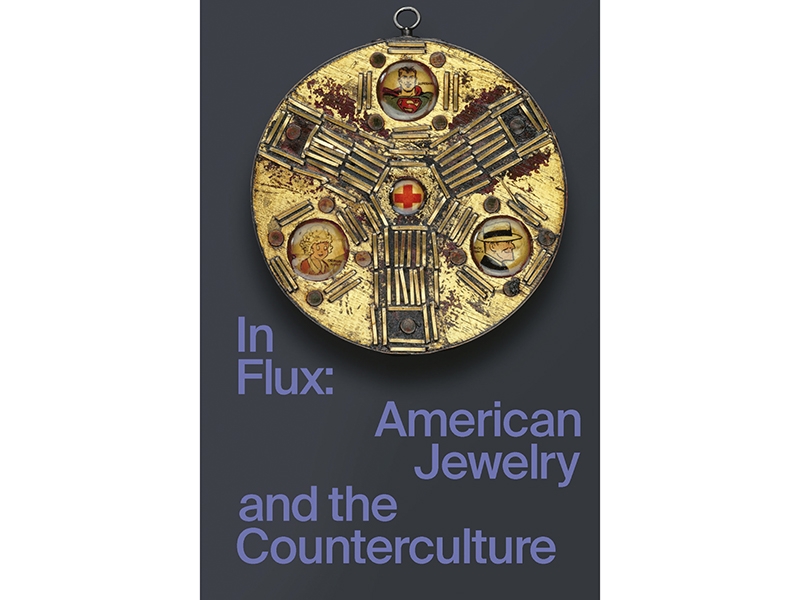
In Flux: American Jewelry and the Counterculture traces the figures, aesthetics, and techniques that blur distinctions between cultural turmoil and studio jewelry. Authors Susan Cummins, Damian Skinner, and Cindi Strauss bring the full force of their combined knowledge in documenting an essential period of American studio jewelry. This topic is overdue for an in-depth exploration; the overlap between studio craft and the counterculture was considerable, and historians have begun the work of interpreting this interaction. For example, the 2011 book West of Center: Art and the Counterculture Experiment in America, 1965-1977 provides multiple nuanced, craft-focused essays that examine shared themes, figures, and techniques.[1] Yet there remains vital veins between craft and counterculture to be explored, and studio jewelry is particularly rich.
After all, a key tenet of counterculture thought was that modernity had severed the connection between subjectivity and the body, causing individuals to be disconnected from vital modes of self-knowledge and self-expression. In this way, a purposeful engagement with sensuality loomed large, urging both those who fully embraced the counterculture as well as middle-class Americans who used these ideas to temper their daily lives to reimagine what they wore, the activities they took part in, and their perception of their bodies. Jewelry, with its intimacy to the body, was used by many to both signal allegiance to these ideas as well as cultivate personal sensual experiences. In Flux provides a generative ground for a consideration of these tendencies set within a richly detailed examination of studio jewelry.
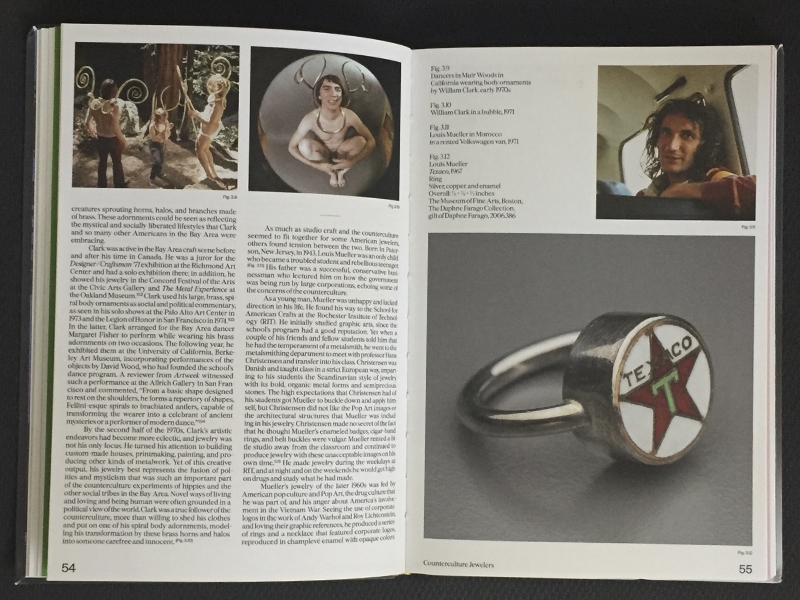
In Flux treats us to the dynamic mixing that forms the background hum of this history, with an ultimate focus on the jewelers themselves. Studio craft is both the site of interaction and entrenched disciplinary techniques; documenting one branch necessitates a working knowledge of many mediums. We see such cross-pollination in the works of Leslie LePere and jeweler Ken Cory—known collaboratively as the Pencil Brothers—as well as Merrily Tompkins, all of whom offer an intriguing variation to the world of Funk art. As the authors demonstrate, the artists’ works share more than visual style; Cory wrote extensively on Funk as a movement, and any future scholar of the genre would be well-served in understanding his work. Yet it is also abundantly clear that such variation isn’t merely a transformation from one material to another.

For example, one spread contrasts the roughly formed toilet set, complete with breasts and penis, of Funk ceramicist Robert Arneson’s His and Hers (1964) across from Cory’s Tongue (1967), a sterling silver brooch with an amber stone and leather form that ingeniously approximates the texture of a tongue. While the anatomical references and rough finishes of the two objects are similar, it is in the differing histories and functions of the two media that their meanings become complex. Arneson’s long standing-commentary on the scatological resemblances of clay and its hierarchically low position in the arts contrasts with Cory’s sly act of placing an active curved tongue on the body of the brooch’s wearer—the former glorying in the ridiculed aspects of one’s field and the latter a commentary on the sensual potential of the body through objects of adornment.

Indeed, the preference for found imagery and sexual innuendo becomes crystalline in the work of the Pencil Brothers, and the authors provide refreshingly matter-of-fact readings of the sexual iconography layered on belt buckles clearly meant to make the viewer think of a penis. This sexual imagery has a different reference point in the work of jeweler Merrily Tompkins—a constant friend and sometimes romantic partner of Cory—whose Snatch Purse (1975) uses a beaver-fur merkin that hangs over the wearer’s crotch, while a speeding train entering a tunnel, depicted in glossy copper and champlevé above the fur, makes it clear that the wearer (unapologetically) wants to have sex. This is just one example of many in which a contextualization of studio jewelry in the broader field facilitates nuanced understandings and new connections.
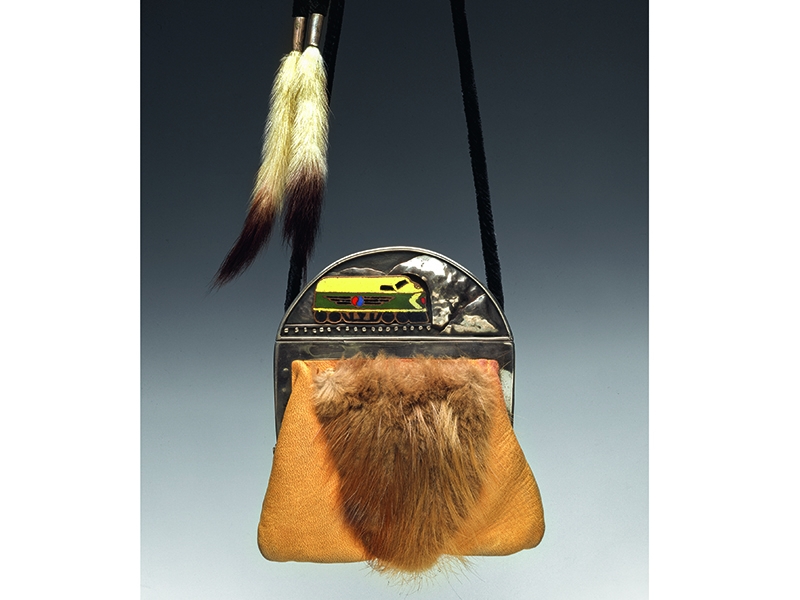
At times the listing of makers became overwhelming as unfamiliar names nestled along the familiar sent me scrambling for my laptop to look them up. Yet this breadth is balanced by the details provided by the many interviews conducted by the authors. These interviews are essential in adding both richness—many of these recollections are plain fun to read—and specificity. As a source, In Flux’s broad focus will give future researchers ample evidence to build upon.
Echoing a tension that is emblematic of the counterculture itself, the question of progressive politics suffuses an examination of studio jewelry. Journalists and commentators frequently contrasted the counterculture with the “New Left,” and suggested the former was an apolitical movement. Yet, as others have argued, the counterculture largely construed was far from apolitical. Rather it tended to operate outside of the “disciplinary politics” that relied upon hierarchy and leadership, instead emphasizing spectacle or utopic experiments as an alternative that blended both culture and politics.[2]
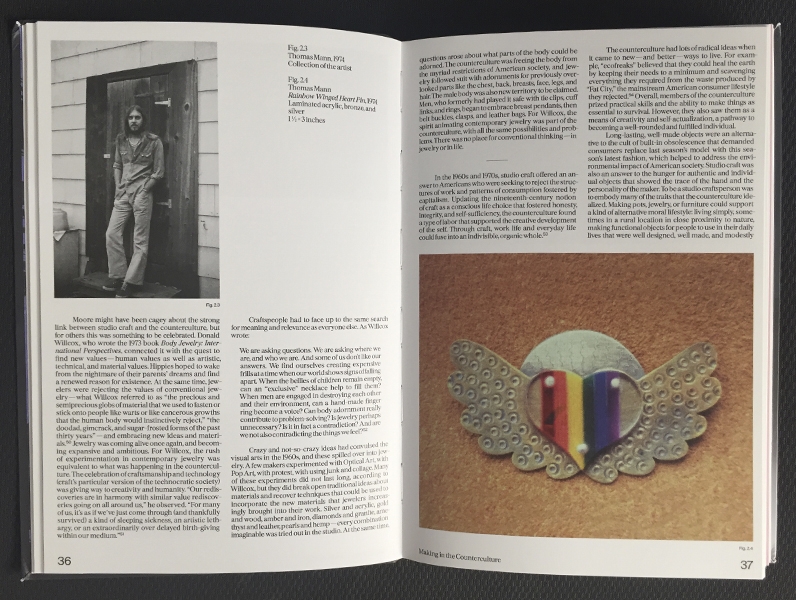
So we might think not of specific objects but of experience as being the true sight of the countercultural politics of craft. What better embodiment of this idea could there be but the many summer workshops where studio crafters shared knowledge through communal living in rural locales? In addition to describing the long-lived schools, In Flux does the essential work of documenting briefer experiments such as the Summervail Workshop started by metalsmith Jim Cotter and painter Randy Milhoan, which ran from 1971 to 1984. At Summervail, craftspeople experienced what metalsmith Jan Brooks described as “cultural democracy,” the ability to speak freely with craftspeople from different disciplines without the constraints of hierarchy or critique.[3]
We get a sense of the potential of this mixing in the story of a “pyromania night” that brought enamelists, glassblowers, and blacksmiths all experimenting with the same huge bonfire. This was pure play, far from the well-honed techniques of their respective fields, and I was left wondering if that was all it was. Did such experiments follow craftspeople back to their home studios after the summer ended? Here In Flux provides extremely generative ground for future scholarship tracing the movement of techniques and aesthetics as influenced by such summer experiences.

Throughout In Flux there are many works and experiences that would fall within more normative understandings of politics. For example, there are works that openly critique the United States and its role in the Vietnam War, such as Richard Mawdsley’s The Tank (1970), a sterling silver and enamel pendant in the shape of gruesome tank with President Nixon’s head. There are also critiques of US imperialism more broadly, such as Louis Mueller’s Colonial America (1968), which provides clear commentary on the US’s role in the Korean War of the 1950s. Yet these examples provide the exception rather than the rule, and it is worth reflecting on the larger political orientation of studio craft during this time. While many in the field both then and now hold dearly to the progressive potential of making by hand, it is necessary to continually ask how such making functions, what role it serves, and for whom.
This is in no way confined to studio jewelry and perhaps forms the most reoccurring thread of inquiry surrounding modern craft practice. In her 1986 study of the importation of the British Arts and Crafts movement in the late 19th century, historian Eileen Boris argued that the moment reinforced social hierarchies by shifting emphasis from structures of employment to ideas of personal satisfaction in work.[4] More recently, art historian Julia Bryan-Wilson has written of the many craft fairs promising a “handmade revolution” that dotted cities and suburbs in the 2000s and she asks what was radical about mass-produced baby clothes with handstitched designs. Though she focused on fiber, one of Bryan-Wilson’s many interventions is to insist craft practice is dizzying in its capaciousness, mobilized to serve any number of political projects both progressive and conservative.[5] It is in exploring this range that the authors of In Flux do some of the most groundbreaking work on the era, putting forth a complex picture of individuals and the structures they were in.
For example, during a student-wide walkout in protest of the Vietnam War, jeweler David LaPlantz (professor at Colorado State University) was spurred not to solidarity but confusion. In his recollections—one of the many interviews that enrich the book—LaPlantz recalls, “I would like to join [the protestors] but I’m split. I have a responsibility to the studio.” LaPlantz’s uncertainty, the split in loyalties and preferences, runs throughout In Flux’s case studies and extends from the makers to the reception of their work.
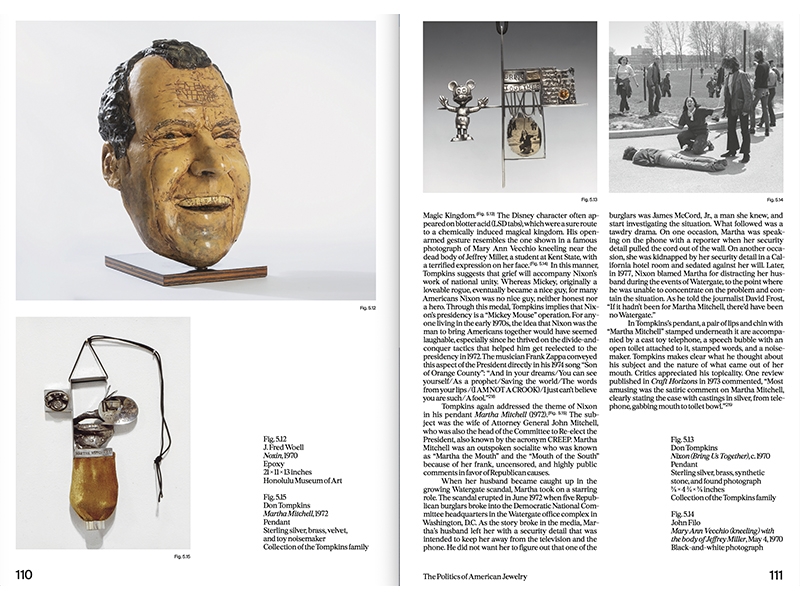
Another particularly clear example can be seen in J. Fred Woell’s Noxin (1970), which takes the form of a giant Richard Nixon mask molded in plasticine and cast in epoxy. As the authors read the piece, it seems clear that it is a critique of the president’s escalation of the Vietnam War, his conservative approach to issues of racial segregation, and more generally his manipulation of the US political system. Yet in the hands of an art writer and gallerist connected with the work, Noxin becomes all subtlety and nuance, a dull commentary on the difficulty of the president’s job. Such a reading is eye-opening and surprising. Yet if we are honest with ourselves as a field, we should admit that there are many such points in the history of the modern craft movement, and the conservative lean of craft is due for serious examination.
If it is incorrect to look for progressive politics in its usual guises, we might be able to find it in the issue of culture and lifestyle. Sociologist and historian Sam Binkley has persuasively argued that cultivating a “lifestyle”—or the emphasis on individual choice in everyday practices—was a primary mode through which middle-class individuals absorbed the counterculture.[6] Within the turbulent politics, economic shifts, and social transformations of the early 70s, the project of reflexively crafting the narrative of one’s life offered potential stable ground. A looser lifestyle—open to new interpersonal experiences, changing patterns of employment, and flexible social roles—allowed one to ride the turbulent wave in ways that felt intentional.
As In Flux demonstrates, studio craft was quick to engage with this landscape. At times the authors fall prey to reifying the liberatory claims about a counterculture lifestyle that were made during the time. For example, the beloved era’s touchstone, The Craftsman Lifestyle: The Gentle Revolution (1976) is referenced as promoting an authentic conception of self without an interrogation of what such authenticity was intended to be or offer. Such questions are particularly pertinent given the pernicious romanization of indigenous craft techniques and Black visual traditions in the name of generating authentic experiences for largely white craftspeople—a tendency that is also clear in the aforementioned summer craft experiences.[7]
Yet balancing this is the authors’ engagement with the founding of the Society of North American Goldsmiths (SNAG), a moment in which rigid hierarchies based on rank and years in the field were maintained. Overall, the picture of lifestyle during this period—like the question of politics—is muddy. While such ambiguity may be frustrating for those who are invested in the field, it is in this muddiness that we can grow a more nuanced history. With this focus on lifestyle, a shift from maker to consumer is useful, prompting the question of how art jewelry functioned for its clientele.
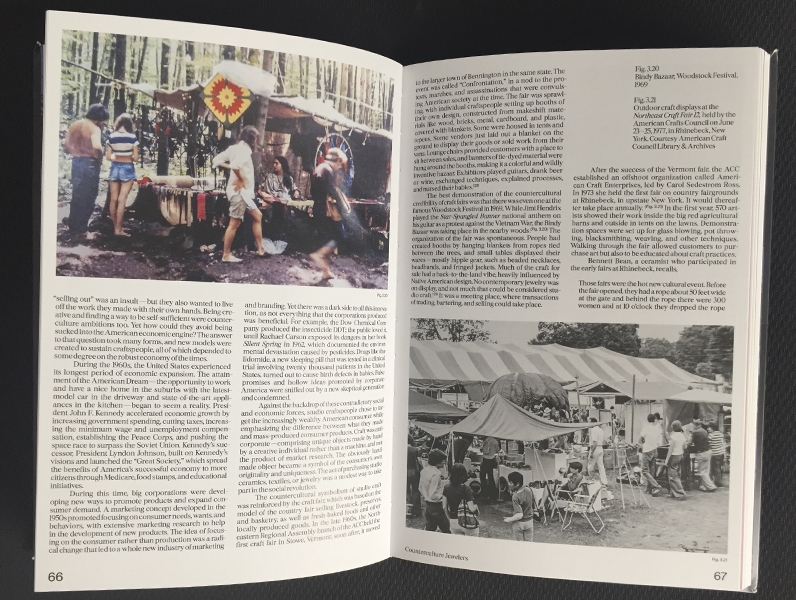
As In Flux documents, art jewelry saw big sales during those years. The authors argue that by buying crafts, consumers made claims about their own lifestyle: “[t]he act of purchasing studio ceramics, textiles, or jewelry was a modest way to take part in the social revolution.”[8] Yet the act of consumption is not the same across all venues; we all know purchasing something late at night on the internet feels different than walking through a small boutique.
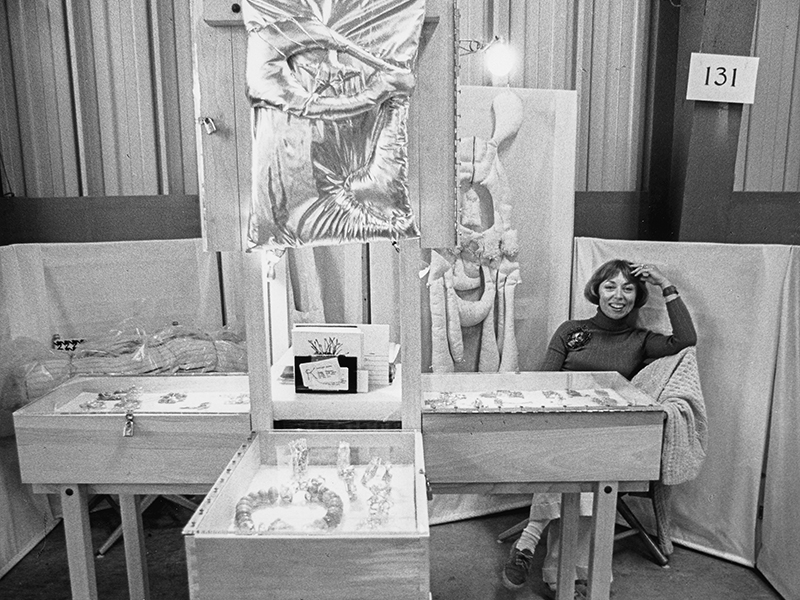
In their attention to atmosphere, the authors follow in the tradition of historians who have looked at the development of department stores in the late 19th century, and they offer important ground to explore the experience of buying and selling craft. The craft fair looms large here, offering both strong evidence for economic impact—the authors detail how the ACC-backed craft fair in Rhinebeck, NY, US, caused the number of people who made a living from selling their crafts to jump from 10% in the early years to 90% by the late 1970s—as well as generative ideas for the social function of the craft experience. For example, a reading of jeweler Carolyn Kriegman’s booth at the 1974 Rhinebeck fair highlights the use of display—lush fiber sculptures and sumptuous glass display cases—to impress and lure consumers. Above all, this section is excellent for highlighting not only how the handmade object functioned for consumers but also how the experience of purchasing these objects served them.
It is difficult to read this book outside of the context of our current reckoning with racist structures. I would argue that rather than attempt to bracket this off, we’d be better off consciously reading this book through the lens of today. Specifically, we should ask how craft constructs whiteness as the default and excludes more diverse voices. These are difficult questions, yet essential both in the goals of understanding our history and shaping better paths forward.
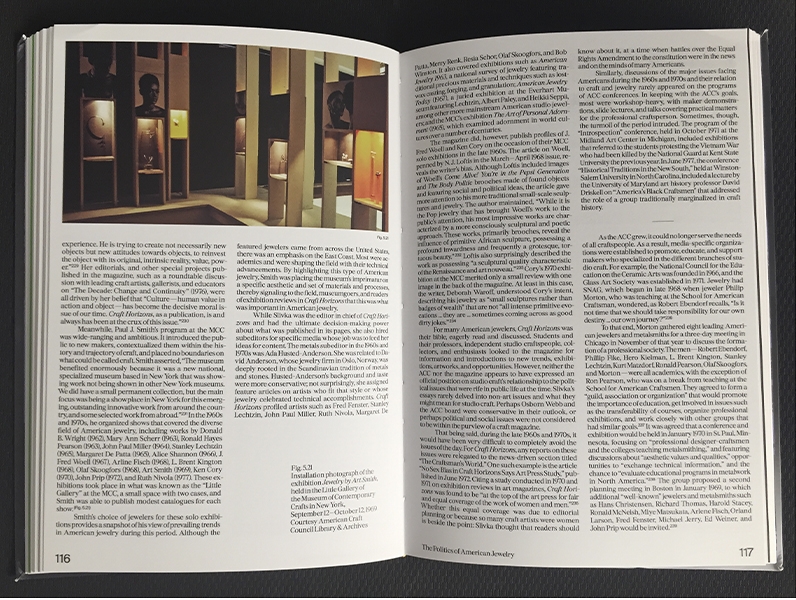
In this regard, In Flux deftly engages with figures from the period who openly asked these questions, such as the pathbreaking curator and writer David Driskell—who we lost last year to COVID-19—who championed Black artists and craftspeople. Yet Driskell ultimately felt that his advocacy “did not have much impact on the ACC’s future activities, including the inclusion of African American artists in Craft Horizons magazine.”[9] The research of the authors seems to bear out this depressing assessment, though they do careful work of documenting the activities of Black makers such as curator and metalsmith Evangeline Montgomery, as well as the early beaded brooches of artist Joyce Scott.

Yet there are missed opportunities here. For example, the authors demonstrate their archival rigor in finding abundant examples of Black Power fist jewelry in the pages of well-known Black periodicals such as Ebony and Jet. While I understand that a focus on commercial jewelers might have been outside the book’s scope, the brief mentions left me wanting more. How might these experienced authors enliven these commercial objects through their expertise with studio jewelry? How might the advertisements for such jewelry refigure works of studio craft that explicitly dealt with race?

To a broader point, is it self-evident that a study of studio jewelry should occlude an engagement with the commercial work of the era? This final question strikes me as particularly germane if a broader attention to commercial jewelers would result in a more diverse array of makers. I personally would love to pick the authors’ brains on how commercial designer Bill Smith’s embrace of Afrocentric designs and body jewelry could enliven our understanding of art jewelry during the period. This is admittedly an open question; all books must weigh issues of expansiveness against issues of legibility. Yet the question did occur to me at more than one point. By holding to the contours of studio boundaries in our historicization, do we replicate the larger patterns of exclusion from 50 years ago? It is messy business to blend these fields, but one that can be productive. This once again demonstrates that In Flux is not (and does not aim to be) the final word on studio jewelry, but instead offers a critical resource and launching pad for future scholarship.
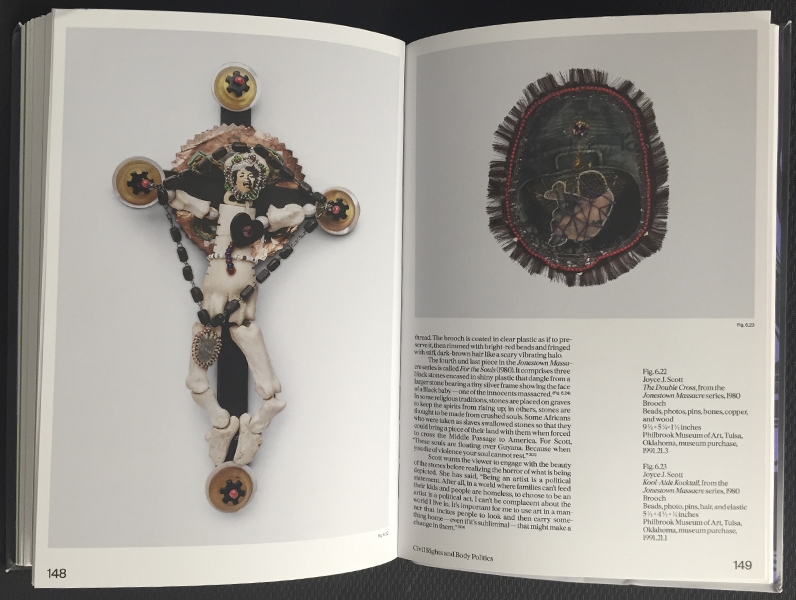
Editor’s note: Authors Susan Cummins and Cindi Strauss will present and discuss this book at the Reading Craft Book Event—In Flux: American Jewelry Packed a Punch in the Turbulent 1960s and 70s, on Friday, July 23, 2021, at 1:00 p.m. EST. They will provide insight into the period, artists, and jewelry that emerged during the 60s and 70s. Following the talk, there will be a Q+A discussion with the audience. Attendees are encouraged to read the book in advance of the event. (The book is available for purchase from the Museum of Fine Arts Houston’s bookshop.) The event is presented by Craft in America and will be streamed live via Zoom and Facebook. Register in advance: https://zoom.us/webinar/register/WN_rCUj3dheSPyWQakr257TIA. Submit any questions ahead of time to center@craftinamerica.org.
This book was produced through AJF’s fiscal sponsorship program, which provides financial management for projects in the art jewelry field. (For information on our fiscal sponsorship program, please go here.)
[1] Elissa Auther and Adam Lerner, eds., West of Center: Art and the Counterculture Experiment in America, 1965–1977 (Minneapolis: University of Minnesota Press, 2012).
[2] Julie Stephens, Anti-Disciplinary Protest: Sixties Radicalism and Postmodernism (Cambridge: Cambridge University Press, 1998).
[3] Susan Cummins, Damian Skinner, and Cindi Strauss, In Flux: American Jewelry and the Counterculture (Stuttgart: Arnoldsche Art Publishers, 2020), 43.
[4] Eileen Boris, Art and Labor: Ruskin, Morris, and the Craftsman Ideal in America (Philadelphia: Temple University Press, 1986), 191–193.
[5] Julia Bryan-Wilson, Fray: Art and Textile Politics (Chicago: University of Chicago Press, 2017), 25–36.
[6] Sam Binkley, Getting Loose: Lifestyle Consumption in the 1970s (Durham: Duke University Press, 2007), 19–20.
[7] Cummins et al., 41–44.
[8] Ibid., 66.
[9] Ibid., 144.




